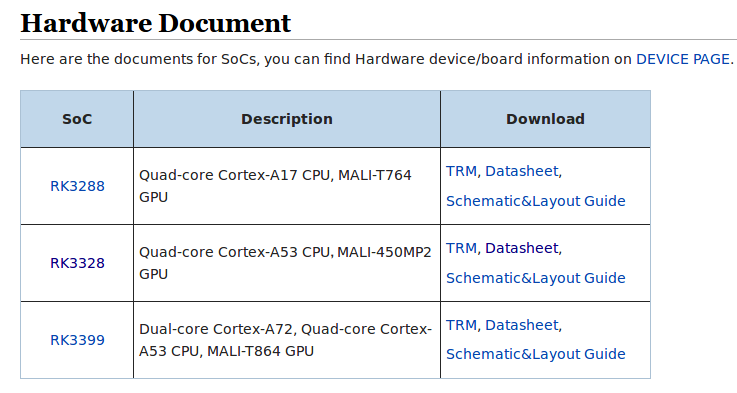As a young engineer, I first understood the importance of good documentation thanks to an incomplete Holtek MCU datasheet that made us waste weeks of development, and the value open source software thanks to Sigma Designs’ SDK that was full of binary blobs with our applications often crashing inside those, leading to software development delays, especially since we had access to limited support. More recently, if you ever worked with the most popular Chinese processors found in ARM Linux development board, usually made by Allwinner, Amlogic, or Rockchip, you must have gone through roadblocks due to a lack of documentation and software support. So far, Allwinner is purely relying on linux-sunxi community and “leaks” of their documentation and SDKs, while Amlogic has had their “open linux” microsite for several years, but you won’t find complete documentation like technical reference manual, schematics, and part of the source code requires you to sign an SLA. I’ve heard people who signed the later, still have problem with accessing the source due to lacking username/password though. But that’s still better than nothing, and probably explains why Amlogic is the has been the preferred ARM target for Kodi in recent years. The company also contracted Bay Libre to add support for Amlogic processors in mainline Linux.
Rockchip was very much like Allwinner at the beginning, but as the company worked with Google on Chromebooks, they started to push code to mainline linux and u-boot, and last year, they also created a Rockchip Github account and Wiki on Wikidot, where you could find some information about the processors. The company has now launched their own open source microsite on their own website: opensource.rock-chips.com. The new website will replace Wikidot Wiki for new processors, and for now they have hardware documentation for RK3288, RK3328 and RK3399, including the technical reference manual, datasheet, and a “guide” to design schematics and PCB layouts. The later mostly consists of PDF schematics of their reference platform. That’s progress, but I don’t understand why an SoC company would not release the full hardware design for their own board.
You’ll find links to source code for u-boot, Coreboot, ARM Trusted Firmware, and Linux on the website, as well as software development guides and tools, including a Linux porting guides, BSP module user guides, graphics and multimedia user guides (GPU/VPU/ISP), and tools like Rockusb abd Rkdeveloptool.
They also have a dedicated email address opensource [at] rock-chips.com for people who want to provide feedback about the website. This kind of initiative with a public release of hardware and software documentation and source code, benefits both customers, especially smaller companies, and Rockchip themselves, since they may not need to deploy as many field application engineers (FAE) to sort out issues, and their customers have better chances of successfully completing their projects.

Jean-Luc started CNX Software in 2010 as a part-time endeavor, before quitting his job as a software engineering manager, and starting to write daily news, and reviews full time later in 2011.
Support CNX Software! Donate via cryptocurrencies, become a Patron on Patreon, or purchase goods on Amazon or Aliexpress





